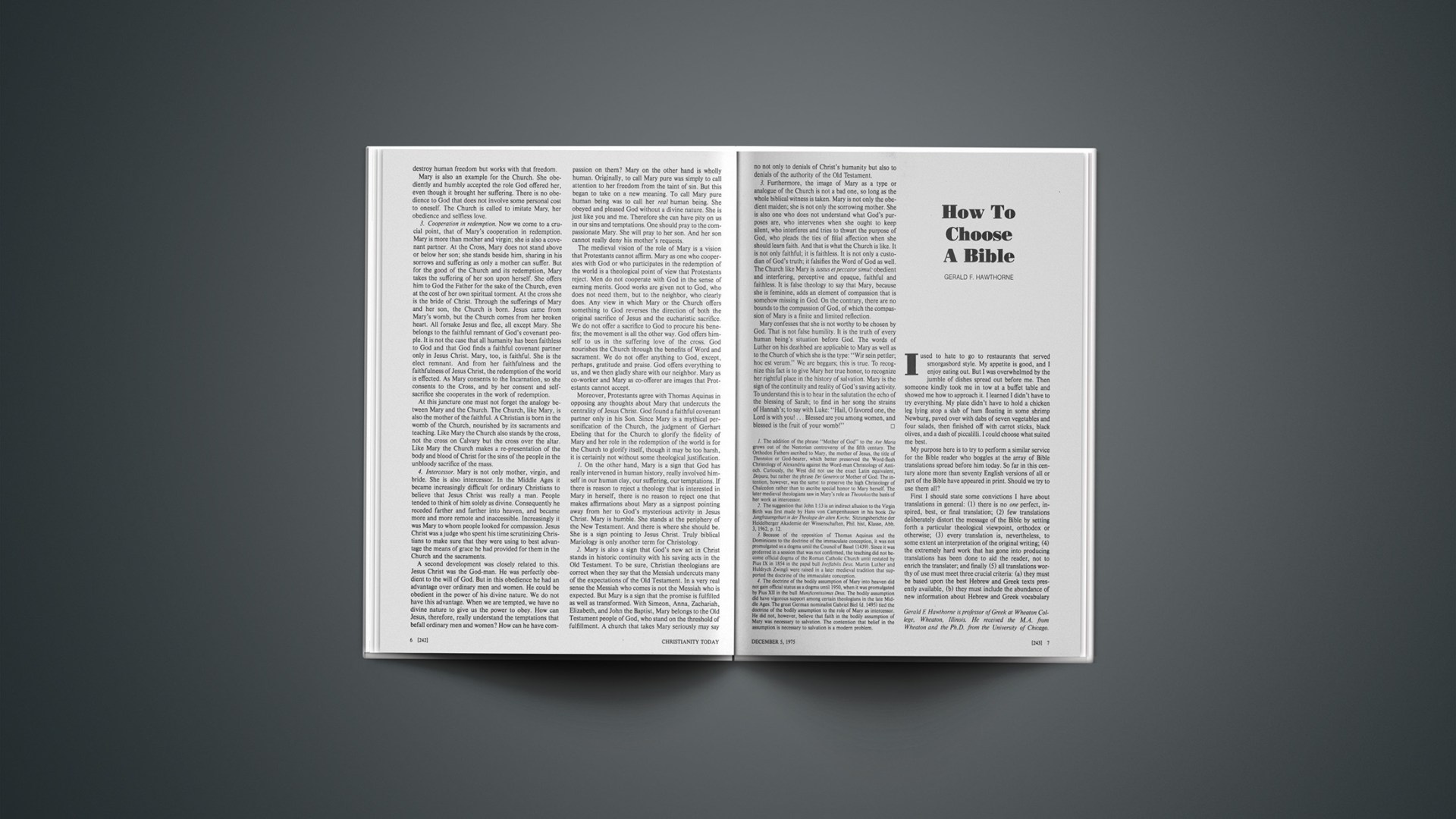I used to hate to go to restaurants that served smorgasbord style. My appetite is good, and I enjoy eating out. But I was overwhelmed by the jumble of dishes spread out before me. Then someone kindly took me in tow at a buffet table and showed me how to approach it. I learned I didn’t have to try everything. My plate didn’t have to hold a chicken leg lying atop a slab of ham floating in some shrimp Newburg, paved over with dabs of seven vegetables and four salads, then finished off with carrot sticks, black olives, and a dash of piccalilli. I could choose what suited me best.
My purpose here is to try to perform a similar service for the Bible reader who boggles at the array of Bible translations spread before him today. So far in this century alone more than seventy English versions of all or part of the Bible have appeared in print. Should we try to use them all?
First I should state some convictions I have about translations in general: (1) there is no one perfect, inspired, best, or final translation; (2) few translations deliberately distort the message of the Bible by setting forth a particular theological viewpoint, orthodox or otherwise; (3) every translation is, nevertheless, to some extent an interpretation of the original writing; (4) the extremely hard work that has gone into producing translations has been done to aid the reader, not to enrich the translater; and finally (5) all translations worthy of use must meet three crucial criteria: (a) they must be based upon the best Hebrew and Greek texts presently available, (b) they must include the abundance of new information about Hebrew and Greek vocabulary and structure now at hand, (c) they must be accurate—at least, their lodestar must have been a determined effort to be true to the meaning of the Hebrew and Greek manuscripts.
Having said this, I move on to a general and simple guideline: let the purpose for which you are reading the Bible determine which translation you use.
For careful study I recommend that you use several translations, but that you begin with the American Standard Version (ASV) or the New American Standard Bible (NASB). These Bibles are exceptionally faithful to the Hebrew and Greek texts. So if you do not know the original languages but want to know what the original says, use either of these two translations.
To know what the Hebrew or Greek text says is not enough, however. It is equally important to know what it means. Literal translations such as the ASV and the NASB can sometimes be misleading. Supplement them with other translations, such as the Revised Standard Version (RSV), the New English Bible (NEB), the Modern Language Bible (MLB), or the Jerusalem Bible (JB), a Roman Catholic version. These are less literal. Their translators were prepared, if need be, to emend the text (but only after careful consideration) or to rely on ancient translations wherever the original documents were obscure or incomprehensible. The goal is not word-for-word but meaning-for-meaning translation. All are invaluable complements to the literal ASV and NASB.
Here too I recommend Today’s English Version (TEV) as a supplement. In my judgment it is a superb example of a meaning-for-meaning translation. Its limited vocabulary and general unpretentiousness should not cause you to omit it as a tool for serious Bible study. Some have called it the most accurate of all translations. The New Testament and several Old Testament books are now available in the TEV, and the entire Bible is due in 1976.
Many of the translations mentioned above are available in study editions that offer clear type, marginal notes, cross-references, full-color maps, concordances, introductions, background information, and other helps. Three of these editions, all using the RSV, deserve special mention: the Holman Study Bible with articles by competent conservative scholars, Zondervan’s evangelically oriented Harper Study Bible prepared by Harold Lindsell, and the Oxford Annotated Bible edited by H. G. May and B. M. Metzger.
Serious Bible study often requires you to read a particular verse or passage in more than one translation, and some single volumes have made this easy. Prices range from $10 to $23. One such volume is The New Testament Octapla edited by Luther Weigle (Nelson). It brings together on each double page the RSV, Tyndale, Coverdale, Geneva Bible, Bishop’s Bible, Rheims, KJV, and ASV. A more recent octapla is The Eight Translation New Testament (Tyndale). On facing pages it shows the KJV plus the Living Bible, Phillips, RSV, TEV, the New International Version, JB, and NEB. Moody Press’s Four Translation New Testament parallels the KJV with the NASB, Williams’s New Testament in the Language of the People, and Beck’s New Testament in the Language of Today. Zondervan publishes The Layman’s Parallel Bible (KJV, MLB, LB, and RSV). Zondervan also publishes The New Testament From Twenty Six Translations. This volume prints the KJV and, right below each KJV line, only the significant differences from the KJV found in the other twenty-five translations. It is a handy tool, but weakened by the fact that the editor gives no criteria for what he considers a significant difference.
In their daily devotional reading, many people go through long sections of the Bible, perhaps in order to read through the entire Bible in a set period of time or to try to grasp its overall message and meaning. What’s needed for this kind of use is a readable, modern English translation. The NEB is one. Its thought flows smoothly. Its literary style on the whole is excellent, with some exceptionally fine phrases. It makes for good reading. Although the NEB may be criticized as an obviously British free translation with a resultant loss of meaning in the finer areas important for exegesis, yet this very freedom helps it impress the reader with the overarching message of the Bible. Cambridge and Oxford University Presses offer the NEB in a wide selection of styles and prices.
Recently I have enjoyed and profited from reading the Scriptures in the Jerusalem Bible. I highly recommend this fine rendering too for devotional reading. Its excellent format and boldface headings are aids to reading with understanding. As a Roman Catholic translation it naturally includes the Apocrypha—interesting, informative, and valuable religious material for Protestants and Catholics alike. Doubleday publishes this Bible in editions that start at $10.
Despite the criticism leveled against the Living Bible (LB), I recommend it here. With its contemporary, vibrant, sometimes racy style, the LB is awakening interest in the Bible everywhere it goes. Although it may not be acceptable for careful, detailed Bible study, it is refreshing and delightful for devotional reading. The most popular edition is Tyndale’s $10 one. Less expensive editions are also available; among them is “The Way,” profusely illustrated to appeal to youth.
For a non-Christian who has shown interest in the Bible, I have three suggestions. First, the Living Bible. Although the translator’s bias does show through at times, it is not enough to dull the clearness of the message of God’s Word.
Second, the TEV, which transfers the dynamic message of the Greek New Testament over into equally dynamic English, losing little of the original meaning. And it has a word list at the back explaining many terms that might be unfamiliar to the non-church-goer. The American Bible Society offers the TEV for well under one dollar. Nelson has other editions ranging from $2.50 to $9.50.
J. B. Phillips’s New Testament in Modern English is also excellent. It is a translation that does not read like a translation. I have friends who knew little or nothing about the Christian faith and who could hardly have cared less. Then someone gave them Phillips, and for the first time the Bible came alive for them. They became Christians and are now ardent disciples of Jesus Christ. Phillips is without doubt one of the best idiomatic translations of the English Bible. Macmillan publishes it in both paperback and hardback.
Ever since the Protestant Reformation, the reading of the Bible has had a prominent place in the worship service. People used to carry their own Bibles to church to follow the reading for the day, to read aloud responsively, or to check up on the minister. But today this doesn’t work very well; there are too many translations. To try to follow a passage in, say, your NEB while the minister is reading from the RSV is likely to confuse rather than clarify.
The obvious solution is for a church to choose a version that will be used by both preacher and parishioner in church services. But which one?
The traditional chuch is rather conservative in its form of worship. It cultivates, and properly so, a sense of mystery, awe, and reverence. Hence, I recommend that the translation selected as the “standard” version be one that conforms to what the traditional church is, one that retains dignity, beauty, and a certain loftiness of expression without being unclear.
The New International Version (NIV) would be my first choice if it were complete. When the Old Testament is finished, churches will do well to consider using this version. In the meantime, I recommend the NEB, RSV, or MLB. (The last, the Modern Language Bible, deserves more attention than it has had. It is an excellent monument to evangelical scholarship, combining dignity with readability.) Roman Catholics will do well to choose either the RSV Common Bible or the Jerusalem Bible, both of which include the Apocrypha.
When I was a boy, everyone who could read was expected to read aloud his verse when his turn came at family devotions. We read a chapter a day without fail, round and round the family circle verse by verse. Each of us had his own copy of the KJV. This experience helped me with my oral reading, my appreciation for good English, and of course my overall knowledge of Bible content. But the exalted King James language made it hard for me to understand what I was reading. I suggest that families today use the TEV.
For families with very young children who can only look and listen, the Holman illustrated edition of the Living Bible is a good choice. This Bible, in the vivid language of everyday life with excellent art work to brighten every page, could make family Bible reading a delight even for its youngest member. It costs around $15.
If you plan to start a neighborhood Bible class among persons who are unfamiliar with the teaching of the Bible, I strongly recommend the use of only one translation, not a variety—either the TEV or the LB.
For a study group composed of mature Christians, I urge the use of many different translations, to open the way for a lot of exegetical insights.
The beautiful cadences of the KJV and its position as a masterpiece of English literature tempt me to recommend that it alone be used for memory work. Yet I recall hearing our young son recite First Corinthians 13 after learning it from the TEV: I really understood what that chapter was saying, and best of all, so did he. For memorizing, use a translation that makes the meaning clear. The KJV can no longer be the standard for this important part of the Christian’s development. I have not recommended it for other uses, either, because comparatively speaking it simply does not measure up as an accurate-enough translation (for this reason I have not cited the popular Scofield Bible).
There is no substitute for knowing the Bible from the languages in which it was originally written. Hence my ultimate recommendation is that the Bible reader learn Hebrew and Greek! But this is not a likely possibility for most readers. Alternatively, pause a moment to give thanks for the many English translations at your fingertips. Then suit the translation to the need.










